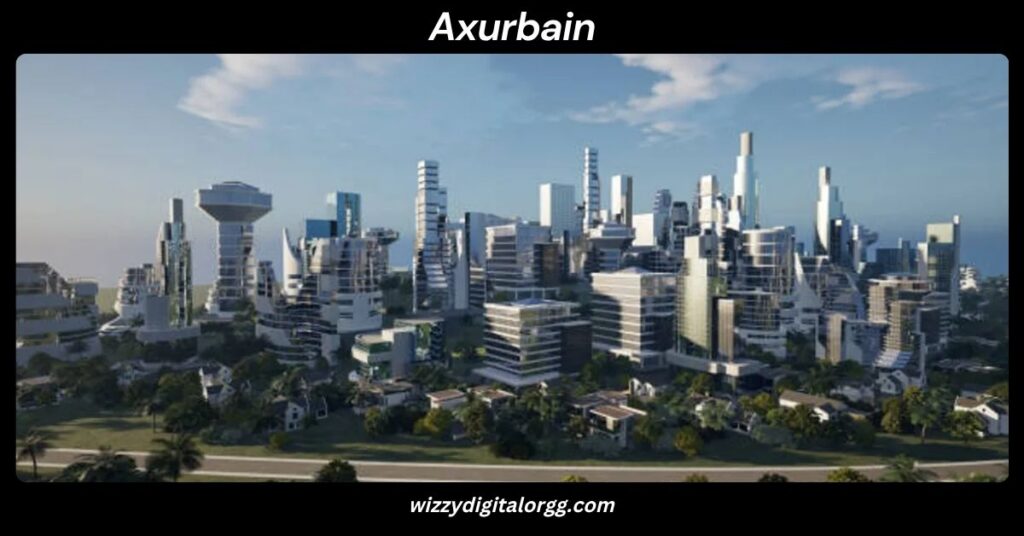
In the face of rapid urbanization, cities across the globe are grappling with the pressing need for sustainable living practices. As more people move into urban areas, the strain on resources such as energy, water, and land increases. The challenges posed by climate change, air pollution, and the depletion of natural resources have given rise to innovative solutions. Axurbain is one such solution that is redefining urban landscapes by integrating sustainability into every facet of city living. From eco-friendly architecture to renewable energy sources, Axurbain aims to create a harmonious balance between urban life and nature.
What is Axurbain?
Axurbain is a novel urban planning concept that merges sustainability with city living. It focuses on creating self-sufficient, green, and eco-friendly environments that prioritize human well-being while reducing the environmental footprint. The term Axurbain is a blend of “urban” and “sustainability,” which together define the vision of a city where sustainability is at the core of daily life, and nature is seamlessly woven into the urban fabric.
At its heart, Axurbain is a movement towards making cities more livable, greener, and technologically advanced in a way that benefits both people and the planet. It aims to counterbalance the negative environmental effects of urbanization and restore the connection between urban dwellers and the natural world.

Key Elements of Axurbain
To understand the full potential of Axurbain, it’s important to break down its fundamental elements. These pillars work together to create cities that are not only functional but also restorative for the environment.
Also Read: Software beealbel28.2.5w418d Error: Causes, Fixes, and Prevention
- Green Spaces and Urban Parks
Green spaces are one of the most iconic aspects of Axurbain. Urban parks, green corridors, tree-lined streets, and even vertical gardens on building walls play a crucial role in enhancing the city’s natural landscape. In Axurbain cities, the integration of green spaces is not just about aesthetics but also about functionality.
Urban Parks and Gardens: These areas provide residents with accessible spaces to relax, exercise, and connect with nature. They also serve as refuges for wildlife, allowing birds, insects, and other animals to thrive within urban settings.
Health Benefits: Studies have shown that regular access to green spaces can reduce stress, improve mood, and lower the risk of heart disease. The physical act of walking or cycling in parks also helps in boosting physical health. In addition to health, these spaces also promote social well-being by offering spaces for community interaction.
Environmental Benefits: Green spaces help to combat the urban heat island effect by providing shade and cooling the environment naturally. They also absorb carbon dioxide, help in stormwater management, and improve air quality by filtering pollutants.
- Energy-Efficient Infrastructure
In an Axurbain city, energy efficiency is not a mere afterthought—it is integrated into every aspect of urban development. Buildings, transportation systems, and public spaces are designed to minimize energy consumption and utilize renewable energy sources.
Energy-Efficient Buildings: Axurbain cities incorporate high-performance building materials and sustainable construction methods to reduce energy consumption. These buildings use energy-efficient windows, insulation, and roofing materials that regulate indoor temperatures, thereby reducing heating and cooling costs.
Solar Panels and Wind Energy: Renewable energy systems such as solar panels, wind turbines, and even geothermal heating and cooling systems are commonly integrated into Axurbain cities. By harnessing natural sources of energy, these systems significantly reduce a city’s dependency on fossil fuels.
Smart Homes and Buildings: Automation is a key feature of energy-efficient infrastructure. Smart homes equipped with IoT devices can monitor energy usage, adjust lighting, temperature, and even water use based on occupancy, reducing wastage.
Low-Energy Lighting: Streets and public spaces are illuminated with energy-efficient LED lights that reduce electricity consumption. Moreover, street lighting systems are often equipped with motion sensors that adjust brightness based on pedestrian or vehicle traffic, minimizing unnecessary energy usage.
- Smart Urban Planning
Smart urban planning refers to the strategic design and management of cities with the aid of technology. Axurbain cities leverage data, sensors, and automation to optimize everything from waste management to traffic flow. This approach is not just about smart buildings, but also about creating a smarter, more connected urban environment.
Data-Driven Urban Design: Axurbain cities use real-time data to inform urban planning decisions. This data can include traffic patterns, energy consumption, water usage, and even air quality. The use of smart grids allows cities to respond dynamically to changing conditions and reduce inefficiencies.
Green Infrastructure: Beyond just parks, Axurbain cities are designed to incorporate green roofs, rain gardens, and permeable surfaces to improve stormwater management. These features reduce the risk of flooding, purify runoff, and create natural water channels within urban spaces.
Also Read: Manganelo: The Ultimate Guide for Manga and Manhua Lovers
Waste Management: Axurbain cities use advanced waste management technologies, such as waste-to-energy plants and automated recycling systems, to reduce landfill waste and turn waste materials into usable resources.
- Sustainable Mobility
Transportation plays a significant role in urban sustainability, and Axurbain cities prioritize alternative, eco-friendly transport options to reduce emissions, traffic congestion, and pollution.
Electric Vehicles (EVs): Axurbain promotes the use of electric vehicles by providing an extensive network of EV charging stations throughout the city. As more people transition to electric vehicles, cities will see reduced pollution, noise, and greenhouse gas emissions.
Public Transportation: Efficient, low-carbon public transportation options such as electric buses, subways, and light rails are central to Axurbain cities. Public transit systems are designed to be convenient, affordable, and easy to access, encouraging people to rely less on private cars.
Cycling and Walking Paths: Dedicated bike lanes and pedestrian-friendly streets encourage residents to opt for healthier, sustainable modes of transport. These pathways help reduce the number of vehicles on the road, leading to lower emissions and improved air quality.
How Axurbain Impacts Urban Communities
Axurbain is not just about buildings and infrastructure—it’s about improving the overall quality of life for urban dwellers. By focusing on sustainable living practices, Axurbain helps urban communities thrive in a more harmonious and eco-conscious way.
- Improved Health and Well-being
The integration of green spaces within cities significantly impacts residents’ physical and mental health. Access to parks, walking trails, and recreational spaces encourages active lifestyles, leading to lower rates of obesity, heart disease, and mental health disorders.
Mental Health Benefits: Nature has been shown to reduce mental fatigue and increase attention span. Urban areas rich in green spaces provide much-needed respite from the stress of city life, improving residents’ mental clarity and reducing anxiety levels.
Physical Health Benefits: Studies have found that living near green spaces can lower blood pressure and improve cardiovascular health. In Axurbain cities, residents can benefit from an environment that supports both mental and physical well-being.
- Social Cohesion
Axurbain promotes social cohesion by encouraging community interaction through shared spaces. Parks, community gardens, and even urban farms provide opportunities for people to come together, collaborate, and form bonds. Social interaction in these spaces can lead to stronger communities, reduced feelings of isolation, and enhanced neighborhood security.
Also Read: “content://cz.mobilesoft.appblock.fileprovider/cache/blank.html” URI: A Detailed Exploration
Community Engagement: Residents can participate in community gardening projects, sustainability workshops, and local events, which fosters a sense of ownership and pride in their environment.
- Economic Benefits
Axurbain cities not only improve the quality of life for residents but also provide economic advantages. Sustainable infrastructure and green buildings reduce operational costs, both for private homeowners and businesses. Additionally, these eco-friendly developments attract investors and residents who value sustainability.
Job Creation: The construction of energy-efficient buildings, green spaces, and sustainable infrastructure generates jobs in various sectors, including construction, technology, and renewable energy.
Property Value Increase: Properties located near green spaces and in sustainable communities tend to have higher property values. This trend benefits homeowners and can attract businesses looking to relocate to eco-friendly environments.
The Role of Technology in Axurbain
In an increasingly digital world, technology is a driving force behind sustainable urban living. The integration of smart systems, sensors, and automation in Axurbain cities enhances sustainability efforts and streamlines urban management.
Innovative Technologies in Axurbain Cities
- Smart Buildings: Buildings in Axurbain cities are equipped with smart technology that optimizes energy use. Sensors monitor and adjust heating, cooling, and lighting, reducing unnecessary energy consumption.
- Electric Vehicles (EVs): Electric vehicle technology has transformed the transportation landscape. With widespread adoption of EVs, cities can reduce air pollution, decrease reliance on fossil fuels, and offer cleaner alternatives to gasoline-powered vehicles.
- Waste-to-Energy Solutions: Axurbain cities are equipped with waste-to-energy technologies that convert waste materials into electricity or usable heat. This reduces landfill waste and provides a renewable energy source.
The Future of Axurbain: What Lies Ahead?
As the world faces unprecedented environmental challenges, Axurbain offers a sustainable model for the future of urban living. The goal is to create cities that are resilient, self-sufficient, and capable of thriving in the face of climate change.
Sustainability in Urban Design: Future cities will be designed with sustainability as the foundation. We will see even more emphasis on green infrastructure, zero-energy buildings, and urban agriculture. These initiatives will not only create eco-friendly environments but also improve local food security.
Smart City Technologies: As technology continues to evolve, so will the ability to manage cities more efficiently. Future Axurbain cities will likely see more advanced smart systems, such as autonomous vehicles, AI-driven waste management, and urban farming solutions.
Also Read: SFlix Movie: Free Streaming Without Interruptions
Why Axurbain Matters for the U.S.
The U.S. is home to some of the world’s largest cities, and the need for sustainable urban living has never been greater. Axurbain can play a critical role in addressing the challenges posed by rapid urbanization, climate change, and resource depletion in American cities.
By adopting Axurbain principles, U.S. cities can reduce their environmental impact, improve quality of life, and create economic opportunities in green industries. Additionally, as public awareness of sustainability grows, the demand for eco-friendly cities will continue to rise.
FAQs About Axurbain
How does Axurbain improve urban air quality?
Axurbain incorporates green spaces such as parks, rooftop gardens, and urban forests, which naturally improve air quality by absorbing carbon dioxide and releasing oxygen. These areas also help reduce the urban heat island effect, which increases temperatures in cities.
Can Axurbain be applied in existing cities?
Yes, Axurbain principles can be applied to both new and existing urban areas. While new developments can integrate green spaces and sustainable infrastructure from the start, existing cities can retro-fit buildings and implement sustainable solutions such as green roofs, solar panels, and energy-efficient public transportation.
Is Axurbain a global concept, or is it specific to the U.S.?
Although the term “Axurbain” might be more common in certain regions, the core principles of sustainable urban living are global. Cities worldwide are adopting elements of Axurbain to combat climate change and improve urban livability.
What are some challenges in implementing Axurbain in cities?
Some challenges include limited space for green areas, high costs of sustainable infrastructure, and the resistance to changing traditional urban planning methods. However, as the benefits become more evident, cities are beginning to prioritize sustainable development.
How can I support Axurbain in my community?
You can support Axurbain by advocating for more green spaces in your area, using sustainable transportation options like biking or public transport, and encouraging local authorities to invest in sustainable infrastructure. Even small changes, like reducing energy consumption at home, can contribute to the broader goals of Axurbain.
Conclusion
Axurbain represents a groundbreaking shift in how we think about urban development. By blending sustainability with urban living, it offers a blueprint for cities of the future—where nature, technology, and community thrive together. As cities continue to grow, Axurbain provides a necessary path forward for creating eco-friendly, livable, and sustainable urban environments. It’s clear that the future of urban living will be greener, smarter, and more connected than ever before.



